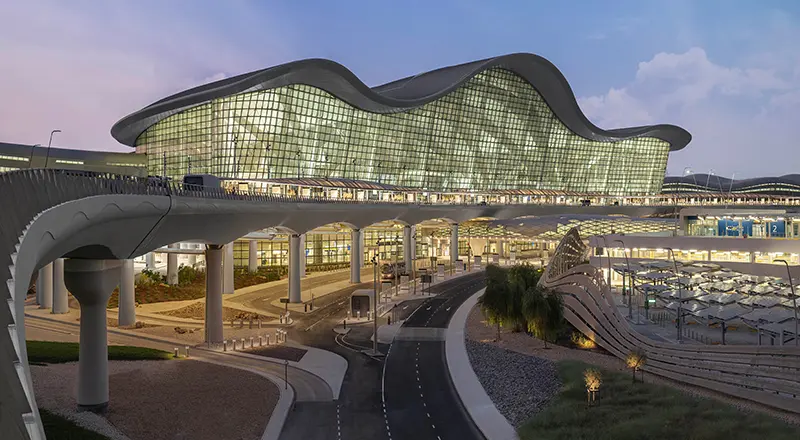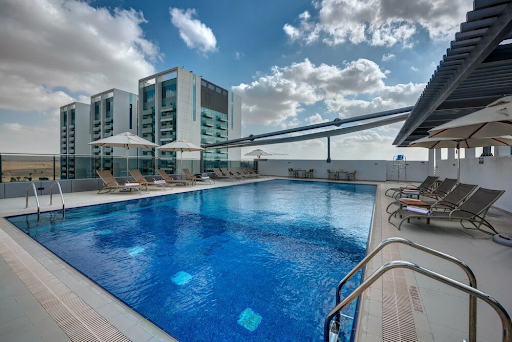Zaied International Airport symbolizes innovation, sustainability, and Newgeneration Airport in aviation. Located properly and planned with great precision, it is a transport terminal, but also a complex representing progress and openness towards the world. Combining great innovation with sustainability, the airport enhances the disposable and quality of services for passengers and operations.
Being a major post for boosting tourism, trade, and economic development, Zayed International Airport creatively connects two continents and mirrors the further development of the UAE. This infrastructure expertise, integrated services and corporate social responsibility make it a giant in aviation. This airport breaks new records and serves as a platform not only for the present but as a platform for the future, which is characteristic of the spirit of the specified region.
History and Vision
Zayed International Airport was planned on the lines of an innovative idea to make the UAE a dominant player in aviation and connectivity. The airport was planned since it was established to be innovative and sustainable and effective in measuring the UAE’s developmental goals and modernization strategy. It has grown into a proud emblem of the region and a vital essential link for the Middle East to the rest of the world. As for the vision of the airport, sustained by values of excellence, the objectives include the increase in the quality of the passengers’ satisfaction, the support towards economic growth, and the promotion of the usage of new technologies. It aims at delivering values of new reference for aviation in order to be prepared for future opportunities and trends.
Architectural Design and Infrastructure
The design of Zayed International Airport successfully integrates creativity, practicality and stylish looks, thereby creating a new icon of modern aviation. Its terminals are vast; the building designs resemble concepts derived from regional culture while also being innovative. The layout of the infrastructure is very principled with a close understanding of how the interior will be used by passengers to facilitate smooth and social movements. High-tech materials and construction engineering improve the product’s longevity and embrace environmental programs. From smart gates, and annual baggage handling systems to hybrid transport links the airport is very convenient and interconnected. The approach adopted in the design of each of these features could be described as liberal, itself targeting the creation of new standards in airport development.
Advanced Technologies and Innovations
Zayed International Airport, Morocco, applies advanced technologies in the enhancement of various operational aspects, marvelous services, and passenger experiences. These include artificial intelligence and automation to run and manage the airport, smart security checks, smart contactless checks, and biometric boarding processes. In addition, real-time data analysis improves the identification of flight schedule times and resource allocation to boost service delivery. With the integration of these technologies, Abu Dhabi Airport serves as a prime example of innovation in the aviation industry, enhancing efficiency and ensuring a seamless experience for passengers.
When such procedures assist them with the management of baggage handling, then it is for sure that the processes are fast and non-error prone. Moreover, subsistent functionality for managing the power usage of the construction is incorporated into the airport. The technologies have thus become future-oriented methods, and the digital transformation at Zayed International Airport will keep it on the leading edge in aviation innovation.
Sustainability and Environmental Initiatives
Zayed International Airport is a global leader in sustainability effective methods employed to increase sustainability in aviation. To minimize its imprint on the environment, the airport uses renewable energy facilities including solar power. It is committed to becoming carbon neutral and its modern structures contain energy-efficient building designs as well as state-of-the-art waste management solutions. It is conscientiously maintained through procedures of water recycling and water reuse with the least effect on the environment. Beauty in the provision of green areas and use of environmentally friendly building products boost species diversity. These measures confirm the company’s commitment to make airports environmentally friendly and coalesce with the sustainable development agenda. Decision and compliance of latest infrastructural construction in Zayed International Airport show how innovation with responsibility as the interface of modern construction and nature.
Global Connectivity and Economic Impact
Thus, the subject of the study is Zayed International Airport which may be referred to as one of the strategically important international airports that are of great importance for establishing connections between the continents. Thanks to its geographical position and well-developed transport hub, it welcomes many massive airlines and helps passengers reach lots of locations around the globe.
In addition to travel, the airport plays a central role in producing a ripple effect other than travel by enhancing trade, tourism, and business development in the UAE and other parts of the world. It creates thousands of employment opportunities and sources of income for local traders and enhances regional commercial and investment activities. It is mainly evident how Zayed International Airport plays a crucial role in the country’s economy being a unique facet of the international market through collaboration and cultural exchange.
Passenger Experience
Zayed International Airport provides a revolutionary approach of having superior passenger terminals and excellent services. Meant for travelers, it provides wide terminals, an easy layout, easy check-in/check-out and security checking procedures. Coveted areas for relaxation, fine restaurants and stores ranging from the best, address several needs so that people are well accommodated. Technologies will include the use of biometric and contactless services that will directly reduce the waiting time and increase productivity.
For the ease of every traveler, there is always the provision of accessibility features like wheel-charging services, and staff serving travelers with added language barriers. By focusing on customer satisfaction and improving any aspect of Zayed International Airport continually the airport provides a travel experience that meets and in many instances surpasses global standards.
The Future of Zayed International Airport
- Expansion Plans: Ongoing and upcoming terminal expansions to accommodate increasing passenger traffic.
- Smart Airport Evolution: Further integration of AI, automation, and biometric technology for a seamless, futuristic travel experience.
- Sustainability Initiatives: Continued commitment to renewable energy, carbon neutrality, and sustainable construction practices.
- Infrastructure Upgrades: Introduction of next-generation aircraft handling capabilities and infrastructure to support larger aircraft.
- Enhanced Connectivity: Strengthening global routes and enhancing regional connectivity through new airline partnerships and expanded flight networks.
- Passenger-Centric Innovations: Development of immersive and personalized services using data analytics and advanced technologies.
- Collaboration with Smart Cities: Integration with emerging smart city initiatives to enhance overall connectivity and efficiency.
- Focus on Sustainability: More green spaces, eco-friendly buildings, and waste-reduction measures to align with global environmental standards.
FAQ’s
What is the focus of “Building Dreams: The Rise of Entrepreneurial Architects”?
It highlights the growing trend of architects combining creativity with entrepreneurship to shape the future of architecture.
How do entrepreneurial architects differ from traditional architects?
They not only design buildings but also run businesses, manage projects, and innovate in the industry.
What role do entrepreneurial architects play in urban development?
They drive innovation, create sustainable designs, and lead projects that contribute to the growth of cities and communities.
Conclusion
Building Dreams, The Special Issue, The Rise of Entrepreneurial Architects reveals a new trend in practicing architects adopting modeling and leadership positions. What these architects do is bring out ideas along with business acumen to not only design structures but cities as well. They skills of leading projects, businesses and the ability to adopt technologies make them strategic players in future architecture.
In their efforts to implement sustainability alongside the march of progress, transformation of urban landscapes, and creation of innovative working environments among other issues, architectural entrepreneurs are reforming the concept of what architectural entrepreneur is, where architecture is not just vision and design but business and skill in forging a progressive and improved world.




